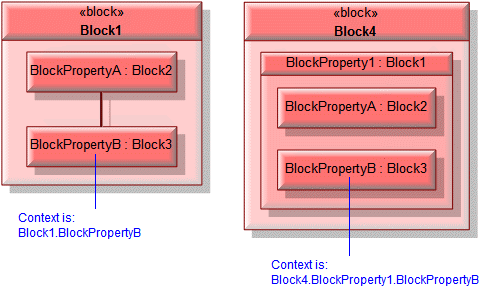Binding connector (SysML item)

A Binding Connector is a connector that specifies that the properties at both ends of the connector have equal values.
Create a Binding Connector between a Block Property, Full Port, Proxy Port or Constraint Parameter and another Block Property, Full Port, Proxy Port or Constraint Parameter: on an Internal Block Diagram or Parametric Diagram, click the  Shallow Binding Connector or
Shallow Binding Connector or  Shallow Uni-Directional Binding Connector button, click the start item, and then click the end item.
Shallow Uni-Directional Binding Connector button, click the start item, and then click the end item.
 Shallow Binding Connector or
Shallow Binding Connector or  Shallow Uni-Directional Binding Connector button, click the start item, and then click the end item.
Shallow Uni-Directional Binding Connector button, click the start item, and then click the end item.Note that Block Properties of type Value can be bound only to other Block Properties that are of type Value. Block Properties of type Part or Reference can be bound only to Block Properties that are of type Part or Reference.
All Binding Connectors are shown in the  Dictionary pane - expand the SysML folder, and then expand the Binding Connections folder.
Dictionary pane - expand the SysML folder, and then expand the Binding Connections folder.
 Dictionary pane - expand the SysML folder, and then expand the Binding Connections folder.
Dictionary pane - expand the SysML folder, and then expand the Binding Connections folder.When shown on an Internal Block Diagram or Parametric Diagram, a Binding Connector's notation is as follows:
 Shallow Binding Connector
Shallow Binding Connector Shallow Binding Uni-Directional Connector
Shallow Binding Uni-Directional ConnectorAfter creating a Binding Connector, you can create Item Flows that are realized by that Binding Connector: on the diagram's tab, click the  Item Flow button, and then click the Binding Connector.
Item Flow button, and then click the Binding Connector.
 Item Flow button, and then click the Binding Connector.
Item Flow button, and then click the Binding Connector.To add a missing Binding Connector: on the diagram's tab, click the  Shallow Binding Connector or
Shallow Binding Connector or  Shallow Uni-Directional Binding Connector button, click the start item, and then click the end item. The context menu that appears lists Binding Connectors that exist between the two items you clicked.
Shallow Uni-Directional Binding Connector button, click the start item, and then click the end item. The context menu that appears lists Binding Connectors that exist between the two items you clicked.
 Shallow Binding Connector or
Shallow Binding Connector or  Shallow Uni-Directional Binding Connector button, click the start item, and then click the end item. The context menu that appears lists Binding Connectors that exist between the two items you clicked.
Shallow Uni-Directional Binding Connector button, click the start item, and then click the end item. The context menu that appears lists Binding Connectors that exist between the two items you clicked.To populate all missing Binding Connectors: right-click the diagram background (not within the Block if shown), point to Populate, point to Links, and then click Binding Connectors. To populate missing Binding Connectors associated with a Block Property or port, right-click the Block Property or port, point to Populate, point to Links, and then click Binding Connectors.
Note that a Binding Connector created between items in context, cannot not be populated between those same items in a different context. In the following example, the Binding Connector shown in Block1 cannot be populated in Block4 because the Block Properties in Block4 are in a different context to those in Block1. However, if you use a  Shallow Binding Connector button to add a new Binding Connector between BlockPropertyA and BlockPropertyB in the context of Block4, the context menu that is opened will allow you to add the Binding Connector in the new context, because the Binding Connector is defined in BlockProperty1's type (Block1).
Shallow Binding Connector button to add a new Binding Connector between BlockPropertyA and BlockPropertyB in the context of Block4, the context menu that is opened will allow you to add the Binding Connector in the new context, because the Binding Connector is defined in BlockProperty1's type (Block1).
 Shallow Binding Connector button to add a new Binding Connector between BlockPropertyA and BlockPropertyB in the context of Block4, the context menu that is opened will allow you to add the Binding Connector in the new context, because the Binding Connector is defined in BlockProperty1's type (Block1).
Shallow Binding Connector button to add a new Binding Connector between BlockPropertyA and BlockPropertyB in the context of Block4, the context menu that is opened will allow you to add the Binding Connector in the new context, because the Binding Connector is defined in BlockProperty1's type (Block1).
Also, the Complete Connector and Complete Binding Connector allows the user to create ports at each end of the connector for the same operation.
The following sections provide information about how a Binding Connector is used in the model. For more information about a SysML diagram or item - click it.
Owned by
A Binding Connector is owned jointly by the two items it links, that is, if either item is deleted the Binding Connector is deleted as well. The access permissions you have to a Binding Connector are determined by the access permissions you have to the item at the start end of the Binding Connector. |
Owns
Shown on these diagrams
SysML Properties
• allocatedFrom - lists source items that are linked through Allocate relationships (on Allocated tab when item is allocated).
• allocatedTo - lists target items that are linked through Allocate relationships (on Allocated tab when item is allocated).












